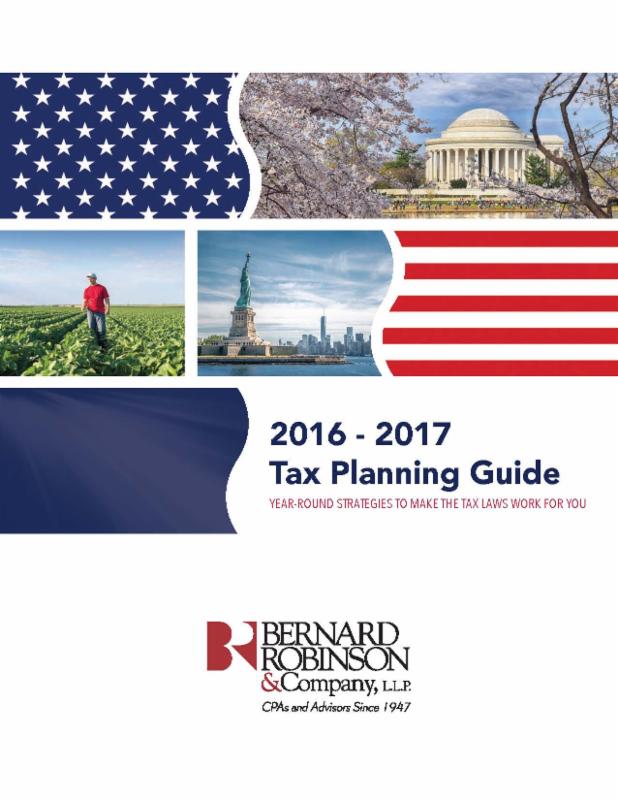|
Andy Harding,
BRC's incoming Business Development Director
On March 1st, we welcomed our new Business Development Director, Andy Harding to the BRC team. Andy holds a Bachelor of Arts degree in Industrial Relations from UNC-Chapel Hill and has over twenty years of experience in business development. In this role, he will be responsible for planning and directing all aspects of the Firm's business development policies, objectives and initiatives and developing and implementing marketing and business development strategies. Andy resides with his family in Clemmons. Welcome Andy!
|
Access Bernard Robinson & Company's 2016-2017 Tax Planning Guide
here!

|
|
 |
|
|
70 Years as Trusted Advisors: Going Above and Beyond
|
By Alisa Moody, CPA, Chief Operating Officer
As part of the 70th anniversary of Bernard Robinson & Company, L.L.P., I have been asked to share a story from my first years with the firm. As a recent graduate joining the firm in 1991, I found myself both prepared and unprepared for my new career. While well taught and tested on the mechanics of accounting, auditing and tax preparation, my experience with a CPA's role as a "trusted advisor" was limited to case studies and theoretical class discussions. I understood that clients trusted their CPAs to provide expertise and advice, but what I discovered during those first years was that it involved much more. I learned being a trusted advisor was more than a role: it is a relationship. Although I could cite many examples, there are few that had the impact of the following example.
One afternoon, I was looking for Freddy Robinson. I found him in the parking lot crouched behind a client's car affixing the renewal sticker to her license plate. As I watched, the client gave him a grateful smile and bid her goodbyes. When he came back inside and found me waiting for him, he explained that this particular woman was recently and suddenly widowed. Although she was well provided for financially, she was less prepared to handle many of the financial and household tasks previously taken care of by her husband. She had been in many times over the recent months, and Freddy had assisted her with instruction on how to write a check, prepare a deposit slip, and on this day, how to renew her vehicle registration.
She was not alone. There were many such visits by those who saw their trusted advisors at BRC as genuine, real people who care about individuals.
It is easy to see why BRC has so many loyal, long term relationships with clients. One of the reasons I came to work for BRC was the emphasis that the partners put on BRC employees as a family. I was pleased to see the family relationships extended to the clients as well. Despite the growth the firm has experienced over the years, this focus on individuals is still at the firm's core, and is one of the reasons I am still part of the BRC team 25 years later.
|
 |
|
Cash Versus Accrual Method of Accounting - Which Should Your Business Use?
|

By Jill Clark, CPA, Manager
One of the many decisions to be made when starting a new business is how the business is going to account for its income and expenses. There are two general methods for doing this: the cash method, and the accrual method. The cash method of accounting generally requires revenue to be recorded when cash is received, and expenses to be deducted when cash is paid. The accrual method of accounting generally requires revenue to be recorded when earned, and the expenses to be deducted when incurred, regardless of when the cash is received or paid.
Depending on the nature of your business, one method may prove to be more beneficial than the other. For example, a business with large amounts of customer receivables may benefit from using the cash method of accounting in order to delay the inclusion of those receivables in income until the actual cash is received. Alternatively, a business with large amounts of vendor payables may benefit from the accrual method in order to accelerate the deduction of those expenses. Therefore, before selecting an accounting method for your business, you should carefully consider the impacts of both methods on your business' income tax liability.
The general rule allows a taxpayer to select which accounting method it wishes to use. However, there are many rules in place that prohibit the use of the cash method of accounting by certain taxpayers. The flowchart below provides a general overview of which businesses are required to use the accrual method versus those that can choose to use either the cash or accrual method. Please consult your tax advisor to discuss the method best suited and/or required for your business.

* Average based on the 3 previous taxable years; gross receipts defined in 1.448-1T(f)(2)(iv)(A)
** As defined by IRC Section 448(d)(2)
*** Businesses that do not produce, purchase or sell merchandise
**** Qualifying businesses are defined in Rev. Proc. 2002-28
|
 |
New Not-For-Profit Disclosures on the Horizon
|

By Ben Ripple, CPA, Senior Manager
As discussed in previous newsletters, the Financial Accounting Standards Board ("FASB") issued accounting standards update 2016-14, "Presentation of Financial Statements of Not-For-Profit Entities" last year. This standard will bring many changes to the financial statements of not-for-profit entities, and for this article I wanted to focus in on some of the additional disclosures that the standard requires.
Qualitative information will need to be disclosed to communicate how organizations manage resources to meet cash expenditure needs. These disclosures will focus on the processes and controls the board and management have in place. Examples of these disclosures include what steps are taken to ensure financial assets are available, such as investing policies that avoid tying up cash in long certificates of deposit, as well as what is done with excess cash. The example in the standard also includes disclosure of the board establishing a liquidity reserve for future years when excess funds exist.
Quantitative information will also need to be disclosed to communicate the availability of resources to meet cash expenditure needs. These disclosures will focus on clarifying what assets on the statement of financial position are actually available. Starting with total assets, you would exclude anything that is not considered a financial asset. Examples of these non-financial assets would include property and equipment, inventories, and supplies. The second step is to remove any items reserved for covering net assets with restrictions. This would be any time or purpose restrictions, including endowment funds. The final step is to remove any assets that have board restrictions, which would include quasi-endowment funds. The disclosures here should also include any access to financial assets that are available to meet needs. So, if an organization has access to unused funds from a line of credit, that would need to be included in these disclosures to paint the full picture of what financial assets are available.
Both of these disclosures should cover a period of 12 months from the date of the statement of financial position, and the main goal of these disclosures is to give the reader of the financial statements a better understanding of how the organization plans to continue to keep the doors open. These disclosures also provide an opportunity for the not-for-profit to show off how much work it is putting in to providing its services by showing the effort that is put into the financial management side of the business. The new standard is applicable for years beginning after December 15, 2017. If you have any concerns about applying these requirements or any of the other requirements of the standard, please reach out to your accounting service provider to ensure you are ready for proper implementation.
|
 |
| Trending Now: Fraud & Identity Theft |

By Casey Cox, CPA, IT Support Specialist
Protecting your social security number may not be the only number to safeguard if you run a business. Your company may have an Employee Identification Number (EIN), which is the business version of a social security number and used to identify it. An EIN is needed to open bank accounts or take out credit, but it doesn't have the same protections that an individual's social security number benefits from. Theft of EINs allows fraudsters to potentially open up lines of credit in the company's name or empty bank accounts.
The steps to protecting your business's EIN are the same as protecting any personal information we discussed previously in the series, with a few exceptions.
- First, much of the personal information of corporations and LLCs is easily searched for on the Secretary of State website, including addresses and names of officers. Keep filing document information at a minimum. If your state does not require disclosure of members' names, do not provide them.
- Verify the accuracy of your business on the Secretary of State website. Fraudsters can easily change your business address or other details by filing a form online. The State accepts these requests in good faith, so it is essential that you check company information on a regular basis.
- Don't provide sensitive information about your company on your website or any other public place. While it is important to provide information to customers, limit details when possible. Fraudsters can accumulate data across the web, and they may eventually gather enough information to pose as an agent of your company.
- Obtain a commercial credit report for your business on an annual basis. This will help you to spot any unauthorized activity.
|
|
|
Bernard Robinson & Company, L.L.P. | (336) 294-4494 |
[email protected] |
1501 Highwoods Blvd, Ste 300
Greensboro, NC 27410
|
|
BRC Strategy is designed to provide information of a general nature and is not intended as a substitute for professional consultation and advice. The opinions and interpretations expressed should not be construed or used as legal or tax advice, written or otherwise, and cannot be used for the purpose of avoiding any penalties that may be imposed under federal, state or local law.
|
|
|
|
|
Copyright © 2015. All Rights Reserved.
|
|
|
|